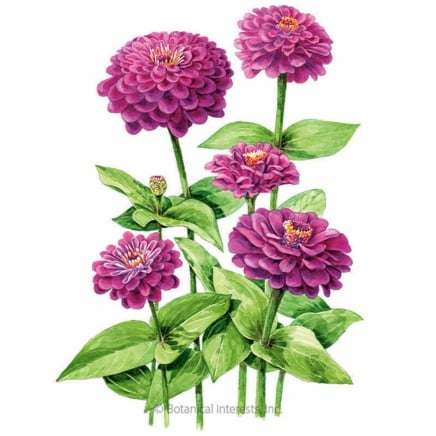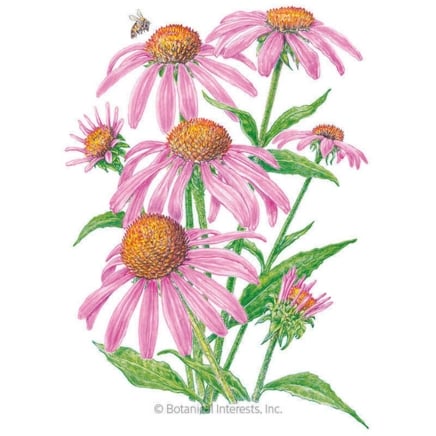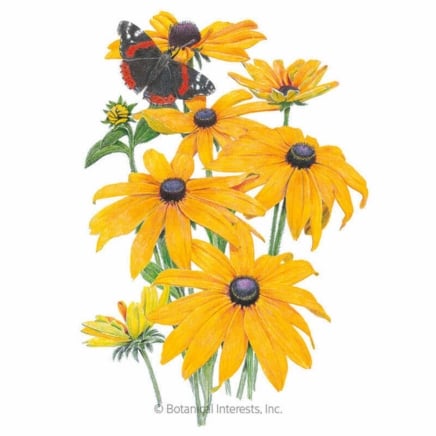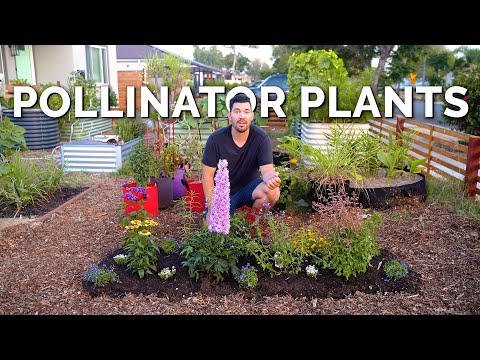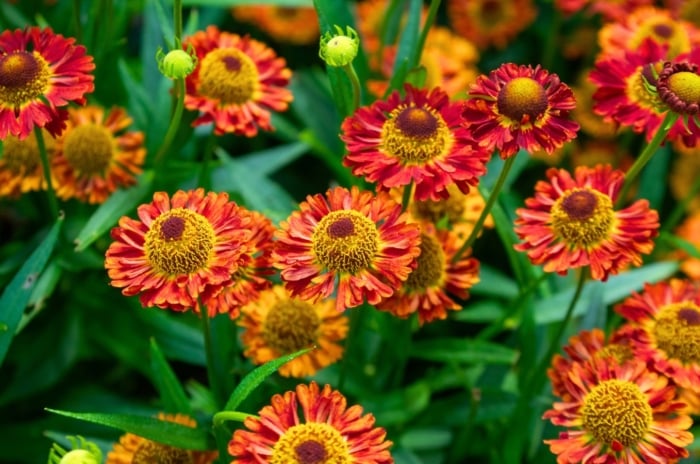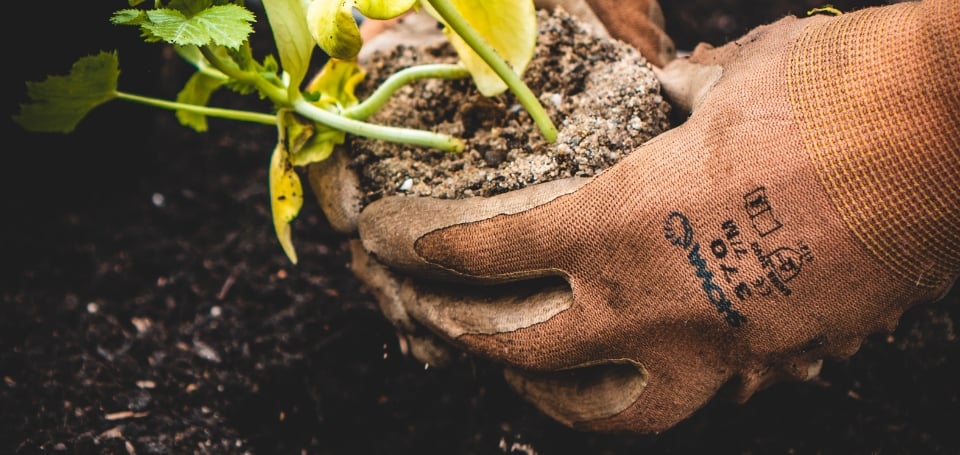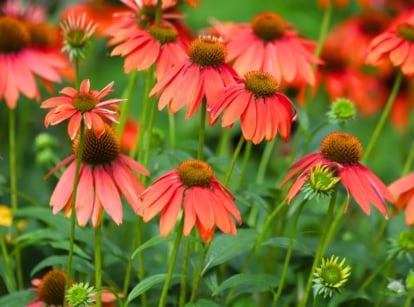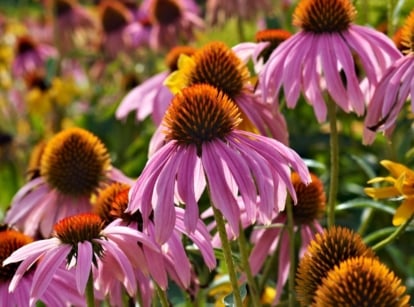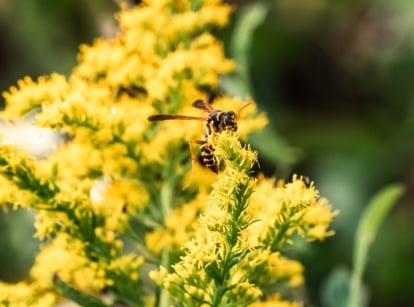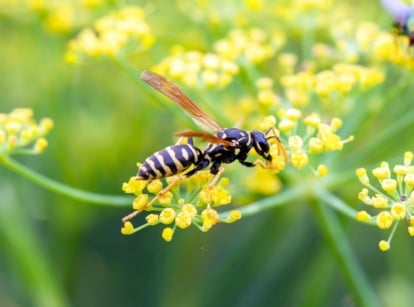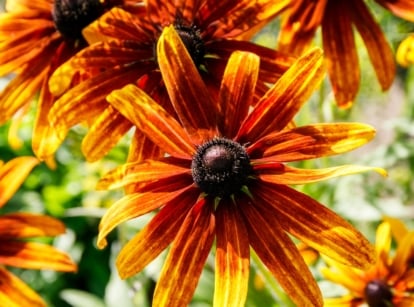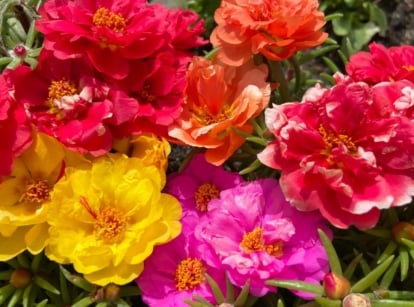15 Essential Pollinator Plants That Boom in August
As the summer comes to an end, pollinators search for sources to provide nourishment for migration and hibernation. By planting these late summer bloomers, we can create a refuge for them in our gardens. Join beekeeper and pollinator enthusiast Melissa Strauss to learn about August bloomers that support pollinators.

Contents
An interesting phenomenon occurs in the lives of pollinators as they approach the end of summer. It may not be something you’ve heard of, or you may know all about it. Either way, it’s the reason I am here to talk about essential late summer pollinator plants.
We refer to this interesting occurrence as the late summer nectar dearth. The word dearth refers to a lack or scarcity of something. It is during this period, from mid to late summer, that there is a lack or scarcity of nectar. Since nectar is the primary food and energy source for pollinators, this is a difficult time for them.
While the exact timing varies by region, it typically includes August, wherever you live. It is in late July and early August that many of the summer-blooming plants begin to fade. The weather is still quite hot for many fall bloomers, so we have a lull in the availability of nectar.
During this time, bees and wasps may be more aggressive, as they become desperate for food. Colonies may struggle to maintain their populations, and the activity of butterflies and hummingbirds tends to decline.
If you want to support your local pollinators during this time, there are specific plants that are particularly helpful. These late summer pollinator plants flower well into the hotter months, and keep pollinators fed during the dearth.
Goldenrod

|
|
botanical name Solidago spp. |
|---|---|
|
|
sun requirements Full sun |
|
|
height 1′-6′ |
|
|
hardiness zones 3-9 |
Goldenrod is one of the best things to plant in your garden to bridge the late summer dearth. It’s an essential late summer pollinator plant across much of North America for precisely this reason.
Goldenrod is a prolific nectar producer. It also produces a moderate amount of pollen, which is an important protein source for bees.
If you plant the right type for your region, goldenrod, for the most part, takes care of itself. It’s drought-tolerant and handles heat and humidity exceptionally well. It self-sows, and once you plant it, you’ll find it springing up around the garden here and there.
When in bloom, you’ll see an incredible assortment of native bees on this plant. Bumblebees are especially fond of it.
Ironweed

|
|
botanical name Vernonia spp. |
|---|---|
|
|
sun requirements Full sun |
|
|
height Up to 12′ |
|
|
hardiness zones 4-9 |
Ironweed is native to the eastern United States. It’s tall, leafy stalks support large umbels of fuzzy magenta flowers. These showy flowers are nectar-rich and bloom in late summer. They are essential late summer pollinator plants and make a nice ornamental addition, too.
Its high nectar content makes planting Ironweed worthwhile. It’s an excellent plant for long-tongued pollinators, such as butterflies and bumblebees. Plant this alongside important larval host plants to attract butterflies to spaces where they can lay eggs.
Mountain Mint

|
|
botanical name Pycnanthemum spp. |
|---|---|
|
|
sun requirements Full sun to partial shade |
|
|
height 1′-3′ |
|
|
hardiness zones 3-9 |
Mountain mint is a native herb found in the Northeast and central states. It has a strong, minty fragrance, and pollinators are highly attracted to the flowers. Small clusters of pale pink to white blooms have purple shoots. The flowers are small but abundant, blooming in late summer.
This critical late summer pollinator plant serves as a magnet for a diverse array of beneficial insects. The volume of flowers can draw dozens to a single plant. They are rich in both pollen and nectar, making them a valuable source of energy and protein. It’s tolerant of poor soil and will grow in partial shade.
Zinnia

|
|
botanical name Zinnia elegans |
|---|---|
|
|
sun requirements Full sun |
|
|
height 1′-5′ |
|
|
hardiness zones 2-11 |
Zinnias are native primarily to Mexico, as well as some Southwestern states. They’re not invasive, however, so they are great annuals for creating tons of color and attracting pollinators. I never visit my zinnias without seeing an array of beneficial insects going about their work.
Zinnias are excellent nectar producers, and the shape of their flowers is an ideal landing pad. Butterflies, bees, and wasps are drawn to them.
You can plant these throughout the summer. They take about two months to bloom. With a seemingly endless array of colors, these are a wonderful ornamental and a high-value late summer pollinator plant.
Joe Pye Weed

|
|
botanical name Eutrochium purpureum |
|---|---|
|
|
sun requirements Full sun to partial shade |
|
|
height Up to 7′ |
|
|
hardiness zones 4-9 |
Joe-Pye weed is a tall, native perennial known for its fluffy mauve-pink flower clusters. It’s a late-season bloomer and has exceptional value to pollinators. Butterflies love it, especially monarchs. Some species can reach up to seven feet tall, but smaller species are also available.
This late summer pollinator plant prefers moist, rich soil, but it tolerates average conditions. It prefers consistent moisture and tolerates partial sun. In hot climates, some afternoon shade is best. This low-maintenance plant is deer-resistant, and many species have fragrant flowers.
Spanish Needles

|
|
botanical name Bidens alba |
|---|---|
|
|
sun requirements Full sun |
|
|
height 1′-3′ |
|
|
hardiness zones 8-11 |
This late summer pollinator plant is a vital source of nectar and pollen in the Southeast. I have a great deal of this in my yard. It grows quickly and can be aggressive, so it’s important to pull plants you don’t want when they are small. It self-sows bountifully.
Spanish needles are on par with, if not more attractive to, pollinators than goldenrod. They have a long blooming period that spans the entire dearth in their native region. It’s highly adaptable, not at all picky about soil, and requires no care other than controlling its spread.
New England Aster

|
|
botanical name Symphyotrichum novae-angliae |
|---|---|
|
|
sun requirements Full sun to partial shade |
|
|
height 3′-7′ |
|
|
hardiness zones 4-8 |
New England aster is one of the most important native pollinator plants in eastern North America. Its vibrant purple-pink flowers and rich nectar make it a magnet for butterflies, bees, and other insects. It’s especially valuable for its long blooming season that lasts from late summer into fall.
The dense clusters of ray flowers give easy access to many pollinators. It grows well in similar conditions to goldenrod, and the two make a superb pair. The purple blooms of New England aster are an excellent complement to goldenrod’s golden tassels.
Purple Coneflower

|
|
botanical name Echinacea purpurea |
|---|---|
|
|
sun requirements Full sun |
|
|
height 2′-3′ |
|
|
hardiness zones 3-8 |
Purple coneflowers are native perennials and some of the best all-around pollinator plants. They are excellent for gardens and wild landscapes.
These late summer pollinator plants have bold, daisy-like flowers and a long blooming season. They provide abundant nectar and pollen for a wide range of pollinators and other beneficial insects.
The large, colorful flowers make coneflowers a great ornamental in addition to their ecological value. They make lovely cut flowers with long, stiff stems. If you let them go to seed, they will provide food for overwintering birds. They self-sow, but not aggressively, as their seeds are a good food source.
Black-Eyed Susan

|
|
botanical name Rudbeckia hirta |
|---|---|
|
|
sun requirements Full sun |
|
|
height 2′-3′ |
|
|
hardiness zones 3-8 |
Black-eyed Susans are a beloved native wildflower commonly found growing along highways. The cheerful yellow flowers can brighten even the rainiest of days. Their open flowers and prominent cones make them highly accessible for pollinators.
These are a rich source of nectar and pollen in late summer. They are highly appealing to native bees, and some butterflies use them as larval food.
Black-eyed Susans are flexible and adaptable. They don’t mind poor soil, and in fact, too much nitrogen can make them grow too tall. This causes them to flop over, so rich soil is not ideal.
Anise Hyssop

|
|
botanical name Agastache foeniculum |
|---|---|
|
|
sun requirements Full sun to partial shade |
|
|
height 2′-4′ |
|
|
hardiness zones 4-8 |
Anise hyssop is one of the top late summer pollinator plants for North American gardens. This native, mint-family pollinator plant produces dense spikes of purple to lavender flowers. They are rich in nectar, highly aromatic, and beloved by bees, butterflies, and hummingbirds.
I rarely walk past this plant without seeing every species of bee native to my region. It’s incredibly popular. It has extremely high nectar production and blooms for a long time, extending in both directions from late summer.
Anise hyssop is perennial in some areas, and in others, it self-sows and will return in the spring in this form.
Swamp Milkweed

|
|
botanical name Asclepias incarnata |
|---|---|
|
|
sun requirements Full sun |
|
|
height 3′-5′ |
|
|
hardiness zones 3-9 |
I can never stress enough how essential milkweeds are to late summer pollinators. Every gardener should plant a native species in their pollinator patch. The reason for this is that milkweeds are the sole larval hosts for Monarch butterflies. This is the only genus of plants on which their caterpillars subsist.
Monarch populations are declining rapidly, largely due to the decline in milkweed populations. Swamp milkweed is a pretty cultivar with large clusters of nectar-rich, pink flowers. It plays double duty as a larval host and an excellent nectar source.
Ensure that you plant a native species to best support the Monarchs on their migration journey.
Cosmos

|
|
botanical name Cosmos bipinnatus |
|---|---|
|
|
sun requirements Full sun |
|
|
height 1′-4′ |
|
|
hardiness zones 2-11 |
Cosmos are pretty little annuals that are easy to grow and bloom freely for a long time. They’re excellent nectar plants and attract a wide variety of pollinators. They have open flowers that make a perfect landing pad.
You can plant these in rounds, and they will bloom from early summer until frost. This makes them an ideal pollinator plant. As with many flowering late summer pollinator plants, rich soil can lead to excessive green growth and inhibit flowering. Average conditions are best for your cosmos.
Sunflower

|
|
botanical name Helianthus annuus |
|---|---|
|
|
sun requirements Full sun |
|
|
height Up to 15’+ |
|
|
hardiness zones 2-11 |
I can’t think of a single reason not to plant some sunflowers in the garden. Even if it’s only a handful, I try to grow at least a few each year. This year, I planted a patch of hundreds, and it was a pollinator paradise. Sunflowers are an excellent source of pollen and nectar.
Plant these in rounds, several weeks apart. This will keep a steady bloom that lasts through late summer and into the fall months. I am always delighted by the sheer volume of pollinators that turn up on just one sunflower. They are magical!
Spotted Bee Balm

|
|
botanical name Monarda punctata |
|---|---|
|
|
sun requirements Full sun to partial shade |
|
|
height 1′-2′ |
|
|
hardiness zones 3-8 |
Spotted bee balm, also known as dotted horsemint, is a native wildflower characterized by its striking, tiered flower heads. It has strong aromatic foliage and blooms in late summer. It’s an exceptional pollinator plant, especially valuable during the late summer nectar dearth.
The mint-scented foliage is attractive to beneficial insects, but not to deer and many nuisance insects. It tolerates some shade and a range of soil types, including poor, sandy, and average soils. It stands out for its high nectar production and unique visual appeal.
Mexican Sunflower

|
|
botanical name Tithonia rotundifolia |
|---|---|
|
|
sun requirements Full sun |
|
|
height 4′-6′ |
|
|
hardiness zones 2-11 |
Mexican sunflowers are vibrant, heat-loving annuals that are exceptionally valuable to pollinators. They’re especially beneficial during late summer and fall when nectar sources are dwindling. Not to mention, they are showy and beautiful, and make outstanding ornamentals.
Bright reddish-orange, daisylike flowers bloom in late summer until frost. This makes them essential for migrating butterflies, especially Monarchs. The flowers are especially rich in nectar.
Mexican sunflowers are bold, beautiful, and among the most pollinator-attracting flowers you can grow.

